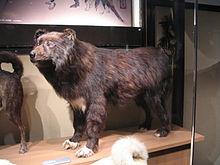You can help expand this article with text translated from the corresponding article in Japanese. (March 2021) Click [show] for important translation instructions.
|
 Jiro, on display at the National Museum of Nature and Science | |
| Species | Dog (Canis familiaris) |
|---|---|
| Breed | Sakhalin Husky |
| Sex | Male |
| Born | October , 1955 Wakkanai, Sōya Subprefecture, Hokkaido, Japan |
| Died | July 9, 1960 (aged 4) Showa base, East Ongul Island, South Pole |
| Resting place | National Museum of Nature and Science |
 Dr. Hisabu Abe in front of Taro's taxidermy, photographed in 2022 at Hokkaido University Botanical Garden | |
| Species | Dog (Canis familiaris) |
|---|---|
| Breed | Sakhalin Husky |
| Sex | Male |
| Born | October , 1955 Wakkanai, Sōya Subprefecture, Hokkaido, Japan |
| Died | August 11, 1970 (aged 14) Hokkaido University Botanical Garden |
| Resting place | Hokkaido University Botanical Garden |
Taro (タロ; 1955–1970) and Jiro (ジロ; 1955–1960) were two Sakhalin Huskies who survived for eleven months in Antarctica after being left behind by the 1958 Japanese Antarctic Research Expedition. Due to poor weather conditions, the expedition was unable to airlift out 15 dogs, who were left chained and with only a few days' worth of food. Of these 15, seven of the dogs died on the chain, six of them disappeared, and two, Taro and Jiro, successfully overwintered and were discovered by the next research group the following spring. The dogs became a media sensation after their discovery, and became Japanese symbols of perseverance and fortitude. Jiro remained in Antarctica and died there as a working dog in 1960; Taro was brought to Japan, where he died in 1970. Both of their bodies were taxidermied and placed on display, and several monuments to the dogs have been erected in Japan.